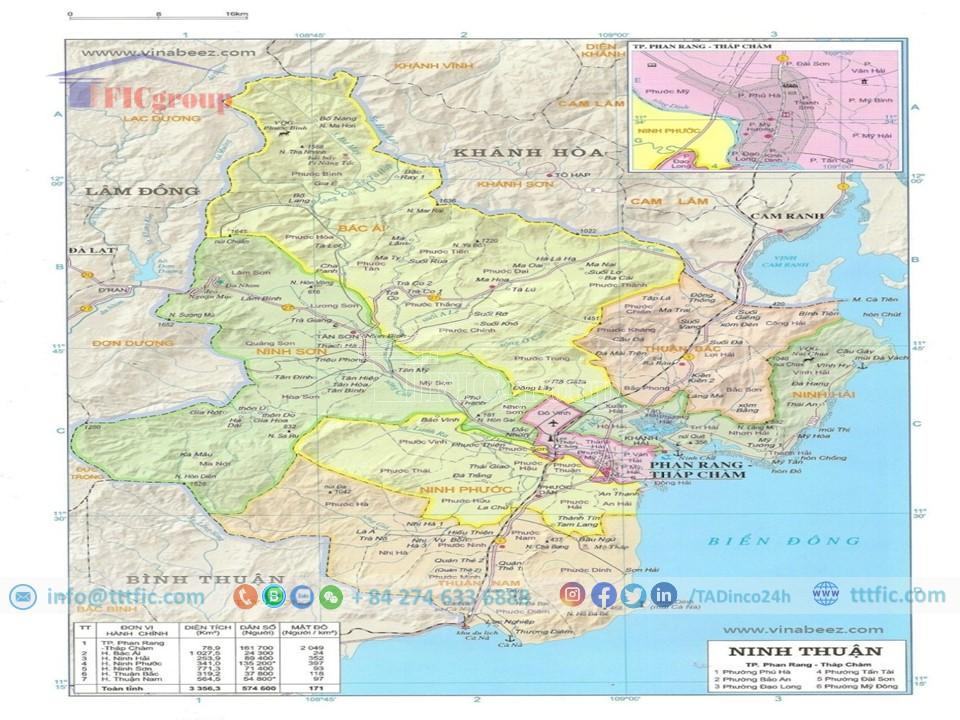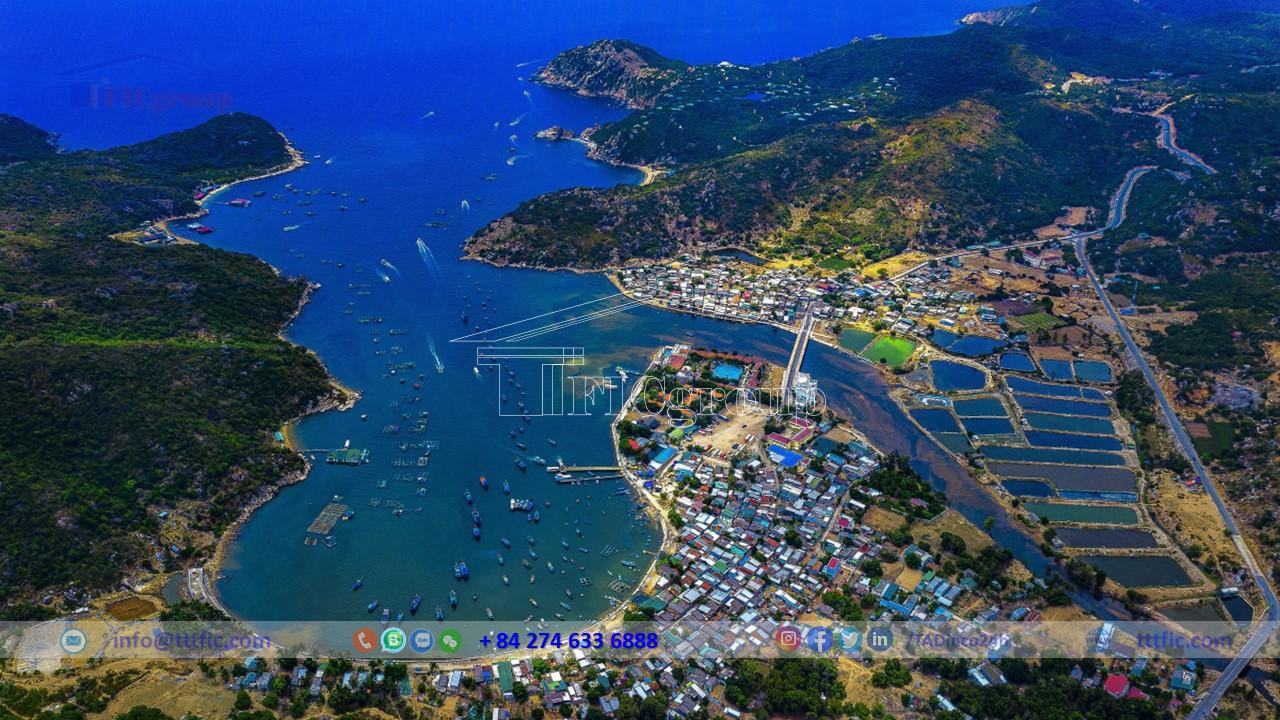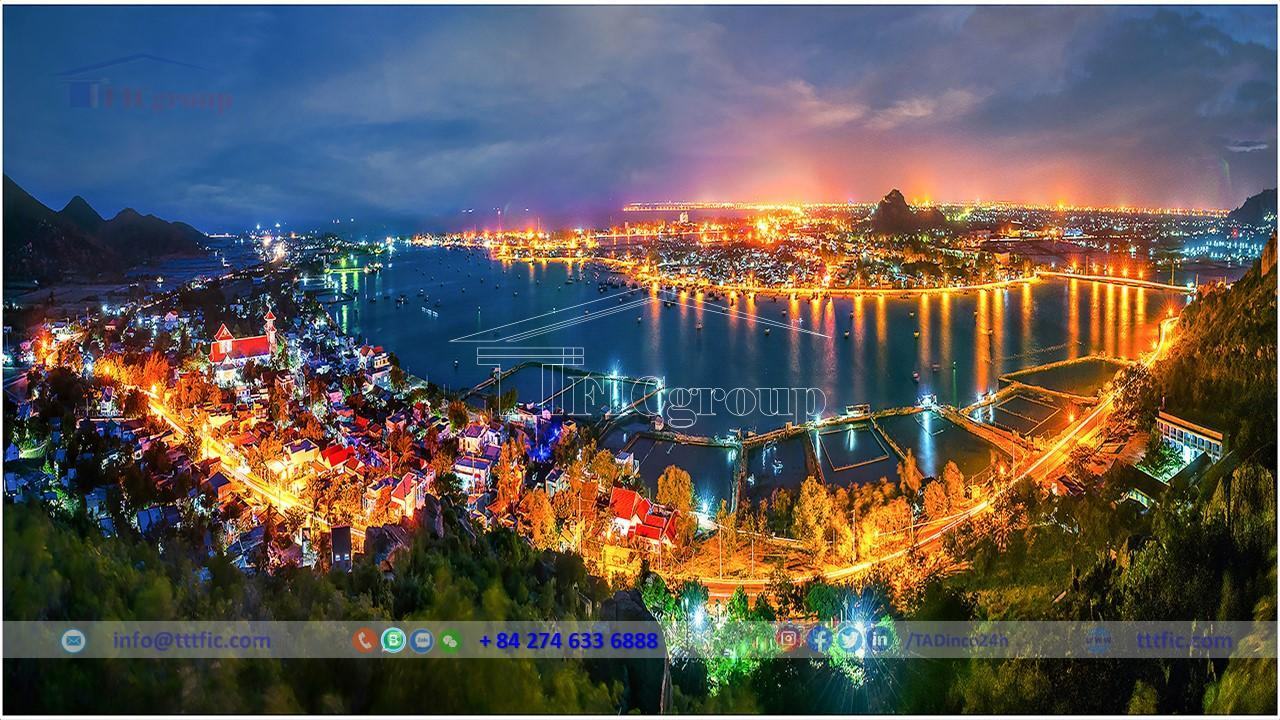Ninh Thuan Province:
Ninh Thuan Province , a coastal province in the South Central Coast region of Vietnam, is a bustling hub of socio-economic activity. The province’s capital, Phan Rang-Thap Cham, is conveniently located at distances of 340km north from Ho Chi Minh City, 642km south from Da Nang, 1380km south from the national capital Hanoi, and in close proximity to other key locations – 100km from Nha Trang via National Route 1, 110km from Da Lat via National Route 27, and a mere 60km from Cam Ranh airport. This strategic location facilitates an efficient exchange and economic growth in the province.
As per the 2018 data, Ninh Thuan ranks as the 58th most populous administrative unit in Vietnam, with a population of 611.8 thousand. Economically, it is the 57th highest contributor in terms of Gross Regional Domestic Product (GRDP), holding the 45th position in terms of per capita GRDP. Impressively, the province ranks 10th in GRDP growth rate. With a GRDP of 24.288 trillion Dong (approximately 1.0549 billion USD), an average per capita GRDP of 39.7 million Dong (equivalent to 1,724 USD), and an annual GRDP growth rate of 10.25%, Ninh Thuan is a vibrant and growing economy.
Geography of Ninh Thuan province:
Geographical location:
Ninh Thuan is in South Central Coast, Vietnam. It borders Khanh Hoa to the North, Binh Thuan to the South, Lam Dong to the West, and the East Sea to the East.
Its total area is 3,358 km², comprising one city and six districts. Phan Rang-Thap Cham is the provincial city. It’s the political, economic, and cultural hub, 350km from Ho Chi Minh City, 60km from Cam Ranh Airport, 105km from Nha Trang, and 110km from Da Lat.
The province looks like a parallelogram with its sharp angles towards the northwest and southeast. Its geographical coordinates range from 11°18’14” to 12°09’15” North latitude and 108°09’08” to 109°14’25” East longitude.
When the Southwest Monsoon brings rain to the Mekong Delta, Southeast, and Central Highlands, the mountain systems in the Central Highlands and Binh Thuan prevent it from reaching Ninh Thuan. Both the Northeast and Southwest monsoon winds get blocked, leaving Ninh Thuan dry while other regions receive rain.
Natural Condition:
Ninh Thuan’s terrain descends from Northwest to Southeast, featuring mountains (63.2%), hills and semi-mountainous areas (14.4%), and coastal plains (22.4%).
The climate is tropical monsoon with hot, dry characteristics, high wind speeds, and strong evaporation. Average yearly temperature is 26-27°C, with rainfall of 700-800mm in Phan Rang and up to 1,100mm in the mountainous regions. Humidity ranges from 75-77%. There are two distinct seasons: the rainy season from September to November and the dry season from December to the following September.
Water resources in Ninh Thuan are unevenly distributed, mainly in the North and the center of the province. Groundwater resources are only one third of the country’s average.
The total natural area is 3,358 km², of which agricultural land is 69,698 ha; forestry land is 185,955 ha; aquaculture land is 1,825 ha; salt-making land is 1,292 ha; and unused land makes up the rest.
The 105 km coastline offers rich and diverse marine resources with over 500 species. The coastal area is suitable for tourism development and aquaculture. Notably, there are rich and diverse coral ecosystems with over 120 species and rare sea turtles.
As for mineral resources, the region has metal minerals like tungsten, molybdenum, tin, and titanium along the coast, amounting to several million tons. Non-metallic minerals include quartz crystals, granite, glass sand, and ceramic clay. Construction materials include granite (850 million m³), lime-bonded sand (1.5 million m³), and coral limestone (2.5 million tons of CaO). Mineral mud with healing properties has been discovered in Suoi Da village, Loi Hai commune, Thuan Bac district.
Economy of Ninh Thuan province:
Despite being primarily agricultural, Ninh Thuan province in Vietnam perennially faces drought with under-invested irrigation infrastructure. Industries and services are undeveloped, with small-scale and low-efficiency businesses. However, through proactive thinking, daring actions, and the collective efforts of its political system, business community, and citizenry, the province has achieved proud progress in multiple sectors.
Economically, the province’s growth rate averaged 8.14% annually over the last 30 years. The Gross Regional Domestic Product (GRDP) in 2021 was 69.6 times higher than in 1992. Despite COVID-19 challenges, the GRDP growth rate remained among the country’s top (14.69% in 2019, 10.02% in 2020, 9% in 2021). By 2021 end, the per capita GRDP reached 68.4 million VND, approximately 88.5% of the national average.
Significant strides were made in marine economics, renewable energy, and tourism. Ninh Thuan’s policy to become the national shrimp breeding hub has been successful, supplying about 30% of the country’s demand. The province’s aim to become a national renewable energy center has yielded positive results, providing momentum for economic structure transformation. The tourism sector showed promise, with an average annual growth rate of 20.6%, drawing 1.7-2.1 million visitors annually. The industrial production value grew at an average of 13.9% per year. Encouragingly, Q1 2022 data from the Statistics Office suggests optimistic trends for Ninh Thuan’s industrial production.
Specifically, in the first quarter of 2022, according to statistics from the Bureau of Statistics, Ninh Thuan’s industrial production showed many positive signs:
Industrial Production:
Ninh Thuan’s Industrial Production Index (IIP) in Q1 2022 increased by 5.33% year-on-year, the lowest rise from 2020 to 2022. High-growth sectors included processing and manufacturing with a growth of 11.25%. Specifically, frozen shrimp production rose by 51.2% and canned beer by 44.6%. Mining grew by 10.73%, largely driven by salt mining, with a slight increase of 0.85%. The price of salt rose nearly 60% compared to 2021, reducing salt stock to 100,000 tons at the end of February 2022, a 60% decrease from 2021.
However, the electricity production and distribution industry only grew by an estimated 3.07%, with total electricity production for the quarter estimated at 1,747 million kwh, including about 1,429 million kwh from renewable energy. Solar and wind energy contributed significantly, although solar energy production fell by 4% compared to the same period.
Among the secondary industries, beverage production rose by 36.11%, chemical and chemical products by 35.71%, food processing by 14.8%, and other mining by 10.73%. However, some sectors like printing and metal product manufacturing saw declines. COVID-19 had an impact, causing difficulties for experts to travel and constraining the consumer market.
Retail sale of consumer goods and services:
Retail sales and consumer service revenue in March 2022 increased 3.2% from the previous month and 17.7% year-on-year, showing a return in consumer demand. For Q1 2022, the total increased by 13.4%, higher than Q1 2021’s 12.5% but lower than Q1 2020’s 14.3%.
Estimated total for March is 2,434.9 billion VND, with retail sales revenue reaching 1,982.2 billion VND, up 5% and 18.5%. Revenue from accommodation and food services was 268.9 billion VND, down 6.5% from the previous month but up 11.4% year-on-year. Other services revenue was 183.8 billion VND, down 0.1% from the previous month but up 19.1% year-on-year.
For Q1 2022, the estimated total was 7,359.2 billion VND, a 13.4% increase from the previous year. Retail sales revenue contributed 81.1% to the total at 5,969.7 billion VND, a 15.5% increase year-on-year. Different sectors saw varied changes: fuels increased 59.1%, household goods 12.1%, and food 10.8%, while clothing decreased 10.6%. Revenue from accommodation and food services rose by 3.4%, and other services increased by 8.3%, despite a 37% decrease in travel revenue.
Export goods:
March 2022’s estimated export value was $6 million, a 45.2% decrease from the same period in 2021. Key exports included seafood at $3 million (down 51.3%), cashew nuts at $1 million (down 58.2%), and other goods, primarily textiles, at $2 million (down 16.7%).
In Q1 2022, the estimated export value was $19.4 million, down 16.5% from the same period last year. Exports included seafood at $11.6 million (up 1.8% due to the primary markets, the US and some European countries, keeping their borders open), cashew nuts at $2.1 million (down 63.7%), and other goods, mainly textiles, at $5.7 million (down 5.6%). The drop in exports is due to border closures by China causing congestion at the Lang Son and Quang Ninh border gates during and after the Lunar New Year, affecting export transportation.
Import goods:
Q1 2022 saw an estimated import value of $43.4 million, a 75.4% decrease from the same period last year. This was due to power projects cutting imports of machinery, equipment, and spare parts. On the other hand, the import of seafood as raw material for production increased by 36.6%, while companies didn’t import raw material for cashew production in Q1.
In general, export and import activities faced difficulties due to pandemic prevention policies implemented by partners at the border gates. The total import and export value in March was estimated at $19.3 million, a sharp decrease of 83.5% compared to the same period last year. For Q1 overall, the total value of goods import and export reached $62.8 million, down 68.6%; of which exports were $19.4 million, down 16.5%; imports were $43.4 million, down 75.4%. The trade deficit for Q1 2022 was $24 million, a decrease of 84.4%.
Social:
Population of Ninh Thuan province:
As of April 1, 2019, the province’s population reached 590,467, with a density of 181 people/km². The urban population was 211,109, accounting for 35.8% of the total, while the rural population was 379,358, 64.2%. The male population was 296,026, and the female population was 294,441. The natural population growth rate increased by 0.44 ‰. This province is the least populated in the South Central Coast region with nearly 600,000 people. The urbanization rate reached 44% by 2022.
According to the General Statistics Office of Vietnam, as of April 1, 2009, there were 34 ethnic groups and 3 foreigners living in the province. The Kinh people were the most numerous at 432,399, followed by the Cham people with 67,274, then the Raglay people with 58,911. The Co Ho had 2,860 people, 1,847 Chinese, and some other minorities such as Chu Ru, Nung, Tay, and others.
As of April 1, 2019, Ninh Thuan province had 10 different religions with a total of 251,292 followers. The largest religion was Catholicism with 97,560 followers, followed by Buddhism with 44,226, Ba La Mon with 62,699, Islam with 44,990, Protestantism with 11,220, and other smaller religions such as Cao Dai with 1,784, Bahá’í with 26, Minh Su Dao with five, and one each for Hoa Hao Buddhism and the Pure Land Buddhist Association of Vietnam.
There are currently 22 Cham villages in Ninh Thuan, distributed in 12 communes and 6 districts: Thuan Bac, Ninh Hai, Ninh Son, Phan Rang – Thap Cham City, Ninh Phuoc, Thuan Nam. The two districts with the most Cham people are Ninh Phuoc and Thuan Nam (separated from Ninh Phuoc in 2009), with a population of 51,527 (as of 1/4/2009).
Most Cham villages follow the Ba La Mon religion, the rest are Muslims with two branches, Bani and Islam.
Education and Training:
The province has 308 schools with 2,721 classrooms at all levels of general education, including 17 high schools with 415 classrooms. There are 27 schools that meet national standards (12.1% of the total) and 85 kindergartens and nurseries with 531 classrooms. The system of general and boarding education has been established in all districts and cities. The training system in Ninh Thuan includes branches of the University of Agriculture and Forestry, Ho Chi Minh City. It also includes Pedagogical College, Political School, DH2 Center – Thuy Loi University, Vocational Intermediate Schools, and vocational and technical centers in districts and cities. Their purpose is to enhance professional qualifications and skills for workers.
Healthcare:
The province has 84 healthcare facilities with 1,585 beds, achieving a ratio of 27.8 beds per 10,000 people. Among them, there are 8 provincial facilities with 810 beds and 73 district and commune facilities with 705 beds (including 65 commune health stations with 325 beds). The total number of doctors is 798. Currently, there are ongoing investments in the construction of a new provincial hospital with 500 beds, district hospitals in Thuan Bac and Thuan Nam with 100 beds each, upgrading Ninh Phuoc District Hospital, Ninh Son Regional Hospital, and regional polyclinics, as well as constructing a Vocational Medical School and an HIV/AIDS Prevention Center.





